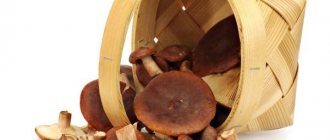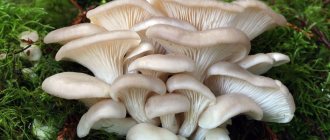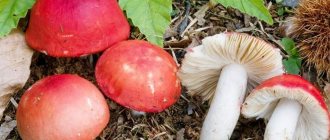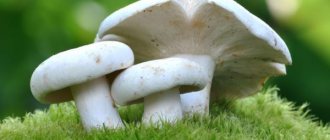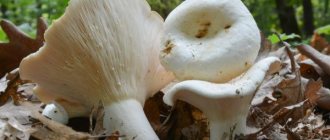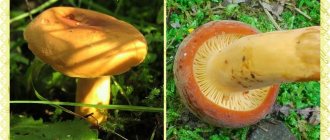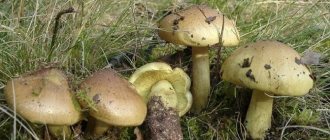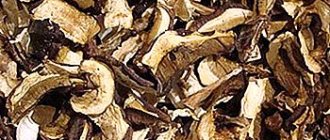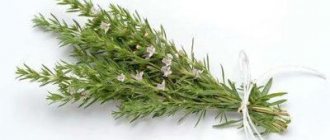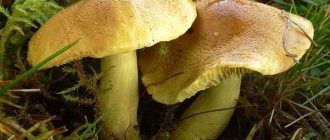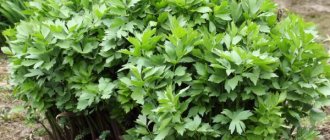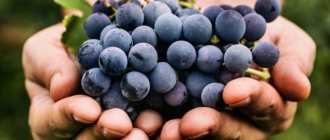Common champignon
Common champignon (lat. Agaricus campestris)
Common champignon (lat. Agaricus campestris
)
People also call it real (214) or pecheritsa. This type of champignon does not produce juice and has a pleasant smell. It can be eaten in any form: fried, boiled, pickled. Does not lose its taste when dried or salted. True champignon grows, as a rule, in large groups on well-fertilized soil, in meadows rich in humus, near livestock farms, and in vegetable gardens near homes. The common champignon begins to bear fruit in the spring and ends in late autumn.
Real champignon
- This is one of the largest representatives of champignons. The leg is white, tall, reaches up to 9 cm, swollen at the base, dense and strong.
The cap of the real champignon has the shape of a convex semicircle (at a young age), and is flat in adulthood. It has a white or grayish skin that is easily removed. The surface is dry, white or brown. In mature mushrooms, the cap can reach 12-15 cm in diameter. The pulp is dense, thick, white, turning pink at the break.
As champignons mature, the plates change color from white, become dark brown with age, and black in older ones.
Common champignon photo
Common champignon (lat. Agaricus campestris)
Common champignon (lat. Agaricus campestris)
Common champignon (lat. Agaricus campestris)
What do common champignon mushrooms look like: photo and description
Category: edible.
The cap of the common champignon (Agaricus campestris) (diameter 6-16 cm): white or light brown, has the shape of a hemisphere, which over time changes to almost prostrate. Velvety to the touch, less often it may have small scales.
As you can see in the photo of this type of champignon, the stem of the mushroom (height 4-11 cm) is the same color as the cap, straight and even, expanding closer to the base. In the middle part it has a noticeable wide white ring.
Plates: change color from whitish to pinkish, and then light brown.
Pulp: white, but noticeably turns pink where it is broken and when exposed to air.
According to its description, the common champignon is difficult to confuse with any other species; this mushroom has no doubles.
When it grows: from late May to mid-October in Eurasian countries with a temperate climate.
Where it can be found: on fertilized soils of parks and vegetable gardens or in cemeteries. Breaking through asphalt and other hard surfaces, this type of champignon mushroom can develop a persistent pressure of seven atmospheres.
Eating: edible mushrooms, common champignons, are used in cooking in almost any form, except for pickling and pickling.
Use in folk medicine (the data has not been confirmed and has not undergone clinical studies!): in the form of a tincture, which has a strong bactericidal effect. This remedy was considered very effective during typhoid epidemics.
Other names: real champignon, pecheritsa (in Ukraine and Belarus).
Field champignon
Field champignon (lat. Agaricus arvensis)
Field champignon (lat. Agaricus arvensis
)
This type of champignon was identified as a separate group by botanist professor Jacob Schaeffer in 1762. “Horse mushroom” - the British call it because of its habitat in places where the soil is rich in horse manure. Therefore, it can be seen near the stables, in pastures, and lawns. It is also found in forest clearings.
Field champignon has excellent taste. You can collect from the end of May until November. Field champignon is edible in all forms.
Field champignon is slightly different from its “brothers”.
The cap can reach up to 15 cm in diameter. To the touch, it is silky, with the remains of a bedspread. At first it has the shape of a bell with curled edges. Over time, it becomes prostrate; in old age, it becomes drooping.
The pulp is white, dense, turns yellow where it is cut, has a pleasant smell and a sweetish taste.
The leg is dense at a young age, but becomes hollow over time. Fibrous, in most cases colored in the same color as the cap. It comes off easily from the cap. The two-layer ring is clearly visible. Height is usually 5-12 cm.
This type of champignon must be collected very carefully.
The field champignon has a great resemblance to the pale toadstool (popularly called the white fly agaric), which is very poisonous. There have been cases of fatal toadstool poisoning.
Their difference is in the plates on the underside of the cap. The champignon has pink plates, while the toadstool has white plates. In addition, the leg of a white grebe in adulthood has two rings, upper and lower.
Field champignon photo
Field champignon (lat. Agaricus arvensis)
Field champignon (lat. Agaricus arvensis)
Difference from other species
Inexperienced mushroom pickers are advised to go on a quiet hunt with a more experienced companion, because there are many dangerous doubles that look very similar to champignons.
False, inedible champignons
Most often, inedible species live in forested areas, but can be found in gardens, parks and meadows. Externally, the inedible fruits are very similar to champignons, but have distinctive features. When pressing on the fruiting body, the twins immediately become yellow, and the cut site at the base becomes bright yellow, which gradually turns orange or brown. Edible ones smell pleasantly of anise, and their counterparts have a “pharmacy” smell of iodine or carbolic acid.
The following species pose a great danger to human health:
- reddish (A. xanthoderma);
- yellow-skinned (A. xanthodermus);
- flat-capped (A. placomyces).
The most accurate way to determine the unsuitability of a mushroom is heat treatment. Mushrooms placed in boiling water turn bright yellow along with the water for a few seconds. When boiling, the unpleasant smell of medicine intensifies, but only for a couple of seconds. These fruiting bodies should not be eaten, because toxic substances do not disappear after boiling.
You may be interested in:
What is the name of a mushroom with a red cap and its description (24 photos) Very often, mushroom pickers encounter many different mushrooms with a red cap in the forest. They usually look very...Read more...
Mushrooms similar to champignons with white plates
In addition to close relatives, the mushroom can also be confused with other similar mushrooms. Young edible fruits are very similar to the pale toadstool and light-colored types of fly agarics.
Spring fly agaric
These poisonous species with white plates live in coniferous and mixed forests, so they can be mistaken for coppice champignon. Its appearance is practically no different from poisonous mushrooms: there are scales on the surface of the cap, the shape of the caps is the same, the white color of the plates and the presence of a ring on the stem.
Death cap
As you know, with age, champignons change the color of the plates, while the plates of toadstools and fly agarics remain snow-white all the time. When pressed, the poisonous fruit does not turn yellow, and its stem always grows from the volva, which is not always clearly visible.
Forest champignon
Forest champignon (lat. Agaricus silvaticus)
Forest champignon (lat. Agaricus
silvaticus
)
Popularly called wolf mushroom. Also known as blahushka and cap.
It is less popular among mushroom pickers due to its reddened flesh. You can eat it in all forms, even raw. It got its name because of its “place of residence.” It has a pleasant smell and excellent taste. Mainly grows in spruce and coniferous forests. Less common in mixed forests. It prefers to grow near anthills and, in frequent cases, at their very top.
The leg is straight or curved. Young mushrooms are solid, but become hollow over time. The thickening in the lower part of the leg becomes thin closer to the cap. Height 5-10 cm. The color of the leg is dirty gray. It has a thin ring at the top. During the ripening process, the ring disappears.
The cap of a young forest champignon is ovate-bell-shaped, the color varies from light gray to brown-brown in maturity. At this age, the cap takes on an outstretched shape. The size of the cap is 5-10 cm, often up to 15. The cap is covered with large brown scales. The pulp, unlike most champignon mushrooms, is quite thin and light. It turns red when cut.
Forest champignon photo
Forest champignon (lat. Agaricus silvaticus)
Forest champignon (lat. Agaricus silvaticus)
Forest champignon (lat. Agaricus silvaticus)
Characteristics of champignons
hat
— Advertising —
The cap is massive, dense, round in shape in young mushrooms, and becomes flattened with age. The surface is smooth, sometimes with dark scales. The color of the cap varies from white to brown and brown.
Pulp
The pulp is colored in shades of white. In air it turns yellowish or reddish. It has a pronounced mushroom or anise aroma.
Leg
— Advertising —
The leg is central, smooth, with a dense structure, sometimes loose or hollow. A one- or two-layer ring, a remnant of a bedspread, is clearly visible on the leg.
August champignon
August champignon (lat. Agaricus augustus)
August champignon (lat. Agaricus augustus
)
Of all types of champignons, this is the largest mushroom. It got its name from the timing of its appearance and ripening. You can find it from mid-August to the end of September, mid-October. Its favorite habitats are coniferous and deciduous forests. It is often found near anthills or directly on them. Grows in groups. But this is not a common mushroom. It doesn't happen that often.
An easily recognizable mushroom. The cap is light yellow with brown scales. Unlike its fellow member of the forest champignon family, which it resembles, the August champignon has the base of the cap not golden, but brownish-brown.
The cap is quite large, up to 15 cm in diameter. It can reach 20 cm. Its color is dark orange or dark brown. Thin. Young mushrooms have a closed, hemispherical cap. With age, the cap becomes prostrate. The edges of the cap are bordered by a large, hanging blanket. A distinctive feature of this mushroom is the brown scales covering the cap.
The records are puffy and loose. With age, they change color from soft pink in youth to brownish-black in old age.
The leg is long and strong. Hollow inside. Covered with flake-like scales of yellow-brown color. On the stem, a large hanging, folded ring is clearly visible, under which scales are also located. The color is whitish-yellow.
The pulp of the August champignon has a pleasant, almond-like smell and is fleshy. On the cut, the color changes from yellow to brown.
Like all mushrooms of this species, it is rich in phosphorus and potassium, vitamins A, B, C, PP, which have a detrimental effect on typhoid pathogens.
The August champignon belongs to the third category of mushrooms in terms of its nutritional value. Very tasty. It is usually consumed fresh, but is also suitable for pickling and drying.
But you should not abuse it because of the ability to accumulate such a harmful substance as cadmium in the body.
August champignon photo
August champignon (lat. Agaricus augustus)
August champignon (lat. Agaricus augustus)
August champignon (lat. Agaricus augustus)
Varieties of champignons
There are several classifications:
- Based on the presence of rings: two-ring and single-ring champignons are distinguished;
- By habitat:
- Forest soil saprophytes: forest champignon, sh. coppice.
- Soil saprophytes of open spaces devoid of plant cover: bisporus champignon, sh. double-ring, or sh. sidewalk, sh. half-shod.
- Herbophiles (only among grass): common champignon, sh. August.
- Growing in open spaces among grass and in forests: field champignon, sh. elegant.
- Desert (including halophiles): Bernard champignon.
Each type of champignon has slight external differences and a special taste. There are also differences in the structure and color of the pulp.
All of the above varieties are edible. But inedible and poisonous champignons are found in nature, which a mushroom picker must be able to distinguish from edible ones. There are also double mushrooms or false champignons, which are similar in description to ordinary champignons. If you look closely, it is easy to find characteristic differences.
Garden champignon
Garden champignon (lat. Agaricus bisporus)
Garden champignon (lat. Agaricus bisporus
)
Common names for this species are cultivated champignon, bisporous champignon, cultivated champignon.
This type of champignon is quite rare in nature. It grows in large groups in roadside ditches, compost heaps, gardens and fields. However, garden champignon is grown industrially in more than 70 countries. This is the most common cultivated mushroom.
Its similarity to the common champignon has led scientists to believe that this species is a variety of the common champignon. But in the process of detailed study in 1906, scientists discovered significant differences between these species, which allowed them to draw conclusions and compare the differences, which ultimately led to the fact that the bisporus champignon was identified as an independent species.
The garden champignon cap reaches 4-8 cm in diameter, round, with curved edges. At the end of the edges are the remains of a cotton, torn bedspread. The surface of the cap in the middle is smooth to glossy, the edges are even and smooth. Champignon has three varieties: white, cream and brown, of which white and brown are found in nature, and cream is only cultivated. The cap flesh is juicy and dense. When cut it turns pink or red.
The leaves of the young champignon are pink. Over time, the color changes to dark brown.
The leg bears a well-defined ring. It reaches a height of 4-10 cm. It has a cylindrical shape. It can be either filled or almost hollow. Mostly white, sometimes with brown spots. The ring is white. It has a characteristic mushroom smell and sour taste.
Due to its taste, it has gained great popularity. Therefore, it is cultivated in very large quantities in many countries of the world, as well as on individual farms.
Garden champignon photo
Garden champignon (lat. Agaricus bisporus)
Garden champignon (lat. Agaricus bisporus)
Where do champignons grow?
Champignons grow on humus-rich soils, on the bark of dead trees and on anthills. Depending on the type of main substrate, they are classified into species that are found only in forests (A. silvaticus, A. silvicola), those growing in open areas (A. bisporus, A. bitorquis, A. subperonatus), growing in grass (A. campester, A. augustus, etc.), found in forests and open areas in grass thickets (A. arvensis, A. comtulus, etc.), desert species (A. bernardii, A. tabularis).
— Advertising —
Champignons are most common in the steppes and forest-steppes of Eurasia, as well as in the prairies, pampas, and meadows of Australia and Africa.
Champignon crooked
Crooked champignon (lat. Agaricus abruptibulbus)
Clearly nodulated champignon (lat. Agaricus abruptibulbus
)
Other names for this mushroom: almond roadside, almond champignon, white champignon, cultivated champignon, clearly nodulated champignon.
The habitats of crooked champignon are coniferous and spruce forests. Likes to settle on spruce floors. Appears quite early, in June. And appears in small groups or solitary individuals. Closer to autumn, the crooked champignon “unites” into larger families, numbering 10-15, and sometimes up to 30 pieces.
The cap reaches 8-12 cm in diameter (sometimes mushrooms up to 20 cm are found). At an early age it has a round, ovoid, closed shape, with edges curved inward. Pure white. Over time, the cap opens and becomes prostrate, changing its color to light pink, sometimes with a purple tint. Has a silky surface. The pulp is not fleshy, thin. When pressed, it turns slightly yellow.
The plates of the crooked champignon are frequent, free, and not attached to the stem. When young, it is white. Over time, the color changes to red-brown, and in adulthood they become black-brown.
The leg is quite large. It reaches 8-12cm in length. Cylindrical shape. At the base, the stem widens and narrows closer to the cap. It has a characteristic bend at the base. After bending, the leg is hollow. In its upper part the leg has a wide, wavy, hanging ring. The ring is single-layer, thin. It is slightly scaly on the inside and smooth on the outside. The flesh of the leg is fibrous, dense and fleshy. White when cut, turns slightly yellow over time.
In terms of its nutritional value, crooked champignon belongs to the third category. Delicious, edible mushroom. In cooking it can be used in first and second courses. It also has excellent taste when marinated and salted.
You can collect from June to October.
The crooked champignon is very similar to the toadstool (a highly poisonous mushroom), so you need to be especially careful when collecting this mushroom.
Planting mushrooms
The substrate was prepared and placed in the cellar on racks. Now it’s the turn to plant mushrooms - this is done using mycelium, which is introduced into the substrate.
The mycelium itself is grown in laboratories under sterile conditions; it cannot be made at home, but it can be bought in a store or ordered online.
For 1 m2 of substrate 500 g of mycelium. It will be necessary to dig grooves every 20 cm, 5 cm deep, and fill the mycelium there.
Shiitake - appearance, composition, benefits and harm, mushroom cultivation + 72 photos
- Talker - description of the species, distribution of the species, benefits and harm + 79 photos
- Gall mushroom - description of appearance, seasonality, taste + 69 photos
During the growth of the mycelium, before the mushrooms have yet appeared, the cellar must be maintained at high humidity of 70-90% and at a high temperature of +20 - +26 °C. After twelve days, the substrate will need to be covered with a layer of peat and wait another 4-5 days.
After the incubation period is completed, the growth of the mushrooms themselves will begin, at which time it will be necessary to lower the temperature to +13 - +18 °C. The growth of mushrooms occurs in waves, one at a time.
The first wave will begin in 3-4 months, at which time the mushrooms will begin to grow very quickly, literally by the hour. The main thing is to make sure that they do not overripe.
When harvesting from the first wave and subsequent ones, in order not to damage the mycelium, the mushrooms should not be cut, but rolled.
Double-ringed champignon
Double-ringed champignon (lat. Agaricus bitorquis)
Double-ringed champignon (lat. Agaricus bitorquis)
People also call it sidewalk, edible, and urban mushroom. This is the most unpretentious mushroom of its family. It cannot be confused with other mushrooms due to its shape, because... its stalk is twice ringed, hence the name of this mushroom).
This type of champignon belongs to the second category in terms of its nutritional value. The mushroom is edible. Grows in deciduous forests rich in humus soils. In addition to forest areas, double-ringed champignon can be found everywhere in urban areas, on roadsides, flower beds, garbage heaps, in parks, gardens and vegetable gardens. Considering the unpretentious growing conditions, the double-ringed champignon has become popular for growing in industrial conditions and in private plots and cottages.
“Loves” warm climates. In terms of its taste, the mushroom is delicious. It can be consumed by boiling, frying or drying.
The mushroom cap reaches 12-15 cm in diameter. At an early age it is spherical, flattened, the edges are bent inward. With age it becomes prostrate, with a depressed center. Thick and dense. Smooth. It has many color shades from off-white to brownish and even brown.
Very thin, frequent and narrow plates. Loose or poorly adherent. When young they are dirty pink. Over time they become dark brown or brownish brown.
The spores are dark brown. When cut, the flesh slowly turns pink.
The leg is fleshy and dense. The height of the leg is 3-7 cm. The thickness is 1.5-4 cm. The leg is cylindrical, smooth, sometimes slightly narrowed at the base. In large cases, the color is the same as the cap.
The double-ringed champignon begins to bear fruit from the end of May and ends in November, with the appearance of the first frosts. Like all mushrooms, double-ringed champignon tends to accumulate harmful substances, so when collecting it in cities and along roads, be careful when processing it and using it for food.
Double-ringed champignon (lat. Agaricus bitorquis)
The benefits and harms of champignons
If the fruits grew in good conditions and did not have time to absorb environmental toxins, then they can be consumed even by pregnant and nursing mothers.
Important!
Forest harvests can only be harmful to people with serious gastrointestinal problems and allergies, but the benefits of eating mushroom dishes are simply enormous.
The mushroom contains a lot of useful substances for humans:
- Minerals: manganese, magnesium, calcium, zinc, sodium, iron.
- Vitamins of group B, E, C, PP, D.
- They contain protein that is easily digestible. Minerals together with protein speed up metabolism, so this product is often included in various dietary dishes.
In addition, the product is also consumed raw - in snacks and salads. When cooked, some of the beneficial substances disappear, but excellent taste is revealed.
Champignon dark red
Dark red champignon (lat. Agaricus haemorroidarius)
Dark red champignon (lat. Agaricus haemorroidarius
)
This type of champignon usually grows in deciduous forests. Rarely seen. Grows in small groups. It can be found under fallen branches and trees. Ripening season – mid-summer, autumn (June to October).
The mushroom is relatively large. The cap reaches 10-12 cm in diameter. At an early age, bell-shaped, with a blunt apex. Over time, it opens up and becomes prostrate. The color of the cap is brownish-brown.
In adulthood, the skin cracks and turns into fibrous scales. The pulp has a mild taste and is white. At the break it quickly turns red. Has a slight sour odor.
The plates are frequent, free, light pink in young mushrooms and brown-black in old age. A characteristic feature is that the plates turn red when touched.
The stem of the mushroom is off-white, hollow, reaches 8-10 cm in height. There is a noticeable thickening at the base. Carries a wide, freely hanging ring, brown in color. Below the ring the leg is scaly. Just like the cap and plates, the stem of a dark red champignon quickly turns red when pressed or broken.
The dark red champignon is an edible mushroom. Has a mild taste.
It is not cultivated on an industrial scale. It is used for food in almost any form. It can be pickled, stewed, fried, dried.
Edibility of champignons
A very small number of champignon species are toxic or inedible, such as the yellow champignon (Agaricus xanthodermus) and the variegated champignon (Agaricus meleagris). All other species are used for food. The bisporus champignon (Agaricus bisporus) is cultivated on an industrial scale.
Fresh champignons are often used even raw, and when heat treated they are an instant product. Young mushrooms are cleaned and washed with cold water, cut into thin slices. Raw champignons are added to salads and cold appetizers. Champignons are also served boiled, fried, stewed, baked, or grilled. Many dishes are prepared based on these mushrooms: first courses, juliennes, vegetable stews, omelettes, pies and pancakes, mushroom pates, sauces, pizza.
Large-spored champignon
Large-spored champignon (lat. Agaricus macrosporus)
Large-spored champignon (lat. Agaricus macrosporus
)
This is a fairly common mushroom. The habitats of this type of champignon are quite diverse. It can be found in almost all European countries. It also grows in England, Asia, and the Transcaucasian republics. The large-spored champignon grows mainly on meadow soils rich in organic matter. The mushroom is large.
The cap is convex and white. At a young age it is fibrous, eventually cracking into wide plates or scales. The edges of the cap become velvety as the mushroom matures. Reaches 25 cm in diameter. At the break it is white, after a short time it turns red.
The plates of the large-spored champignon are free. Very often located. At an early age, pale pink or gray in color. Over time, the plates turn brown.
The leg is filled and dense. It reaches a height of 6-10 cm. It is thickened at the base. It comes in white or off-white color. Fusiform, sometimes covered with flakes. It bears a single thick ring, which is covered with scales on the underside. The pulp is white, slightly reddens over time. When cut, an adult mushroom has an almond smell, which turns into the smell of ammonia.
In terms of its nutritional value, large-spore champignon belongs to the first category of mushrooms, which indicates its beneficial properties for the healing and treatment of our body. Has good taste.
Doubles and false champignons
Champignons have many poisonous counterparts
Deadly mushrooms for humans, which are similar in external characteristics and structure to pecheritsa, are white fly agaric and pale toadstool. Most of all they look like coppice pecheritsa. It is easy to recognize poisonous mushrooms among edible ones by the shade of the pulp at the cut site. In poisonous mushrooms it does not oxidize and retains its original color. An adult edible mushroom changes the color of the plates located on the inside of the cap. In poisonous mushrooms it remains unchanged. The presence of a volva surrounding the swollen base of the leg of the pale toadstool or white fly agaric is another difference between poisonous mushrooms and pecheritsa, which do not have it.
Inedible varieties of pecheritsa are the rufous or yellow-skinned and flat-capped champignons. To determine that pecheritsa is inedible, an incision is made. The cut area turns bright yellow or orange, colors not typical of edible varieties. The mushroom also emits an odor that is similar to the smell of medicine (often called “pharmacy”). If you put an inedible fresh champignon in water, the smell will become more pronounced, and the body of the pepper will turn yellow. The water will also turn yellow. If you cook an edible mushroom, the water will change color slightly.
Irina Selyutina (Biologist):
For yellow-skinned champignon, or sh. The reddish one is characterized by the presence of a swelling at the base of the stem, which is not present in edible representatives of the Champignon genus. According to the degree of toxicity, this species is classified as moderately poisonous mushrooms. This means that if it is eaten, a rather serious disorder of the gastrointestinal tract may occur. Unfortunately, to date, the active substance of the yellow-skinned champignon has not been established. But, despite this, w. yellowskin is used in folk medicine due to the presence of natural antibiotics in its fruiting body.
For your information. When collecting wild champignons, the mushroom picker needs to be very careful, because Yellowing on the stem or cap of the yellow-skinned champignon does not appear immediately, but after some time.
The flat-headed champignon is another mushroom that belongs to the Champignon family and is poisonous. This is a lamellar mushroom with a scaly cap. It is distinguished from its edible brothers in the family by its sharp, unpleasant odor. Yellow champignon is also dangerous. It is distinguished by its large size (the diameter of the cap exceeds 15 cm). When cut, the yellowing mushroom becomes bright yellow. The poisonous champignon, which is called variegated, is rare.
Champignon is not a tubular mushroom, unlike some poisonous varieties. This feature is also used to distinguish edible species from inedible ones in the forest (there are more poisonous species among lamellar species than among tubular species).
Fresh or boiled false champignons contain the same amount of toxic substances that cause disruption of the gastrointestinal tract.
Steamed champignon
Steam champignon (lat. Agaricus Vaporarius)
Steam champignon (lat. Agaricus Vaporarius
)
This is another representative of edible mushrooms of the champignon genus. It is found quite often in Russia. This type of champignon is widespread throughout Europe. Grows in mixed forests, pastures, meadows and gardens. Like all its relatives, it prefers well-manured soil rich in organic matter. Feels good in shaded places where it is not exposed to direct sunlight.
The cap of this mushroom reaches 7-10 cm in diameter. At a young age it has a round, bell-shaped shape. Over time, the cap changes its shape and becomes almost flat. Covered with sparse scales. The remains of the coverlet are visible along the edges of the cap. Color – reddish brown. The pulp is white. Slightly reddens when broken.
Thin plates are often located under the cap. The records are free. At an early age they are light pink in color, while in older mushrooms they are brown.
The leg of a steamed champignon goes deep into the soil. It has a thickening at the base. Its fibrous surface gradually turns into a smooth one. It reaches 7-10 cm in length. In its upper part it bears a thin single ring with drooping edges. The pulp is dense, fleshy. It is white at the break and turns a little red over time. Has the smell of chicory.
According to its nutritional value, steamed champignon belongs to the third category of mushrooms. This mushroom can be collected in September-November.
Just like other types of edible champignons, they can be eaten in any form. A very tasty mushroom.
How to distinguish a champignon from a toadstool (video)
During the formation of primary mass primordia of fruiting bodies, it is very important to gradually, over five days, reduce the air temperature to 14-16 ºС. The room allocated for cultivation must be regularly and sufficiently well ventilated. When the very first mushrooms appear, irrigation measures are carried out daily, but in moderation. The average water consumption for each square meter of planting should not exceed one and a half liters of water. If the cultivation technology is followed, the harvest of fruiting bodies is formed in a wave-like manner over three or four months, with an interval of a week.
Collection is carried out at the stage of maximum size of the aerial part, at which the characteristic filmy cover under the cap should be completely preserved. In winter, it is necessary to pour snow on the roof, which will create a temperature favorable for growing inside the greenhouse space.
Small scaled champignon (Benesha)
Small-scaled champignon (lat. Agaricus benesii)
Small-scaled champignon (lat. Agaricus benesii
)
This is a stocky mushroom. During the ripening process, the surface of the cap cracks into small scales. This is where the name of this mushroom comes from. It grows in both coniferous and deciduous forests. You can also meet it on forest edges and clearings. But this is a rare representative of the champignon family.
This type of champignon has a thick and fleshy cap. In diameter it reaches from 5-9 cm (occurs up to 13-15 cm). At a young age, semicircular, whitish. Over time, it becomes flattened, prostrate, with a blunt, wide tubercle and a brownish color.
The plates are frequent, free, pale pink at first and brown in adulthood.
The leg is white, dense, cylindrical. In its upper part it bears a thin, drooping ring. Above the ring the surface is bare and pink. Under the ring, the leg is covered in irregular rows of rather large flaky scales, whitish or brownish in color.
The pulp is dense, white where it is cut, but quickly turns red. They are usually eaten fresh. It is found in summer and autumn.
The small-scaled champignon is considered a tasty and edible mushroom.
Small scaled champignon (lat. Agaricus benesii)
Growing champignons in the garden
Growing or propagating edible mushrooms yourself in a garden plot is not too difficult, but before planting mushroom seeds or propagating fruiting bodies with mycelium, you need to familiarize yourself with the technology of home mushroom growing. The basic conditions for proper cultivation are presented:
- comfortable temperature range from 22 to 25ºС;
- optimal humidity levels within 85-95%;
- the presence of a gaseous environment and intensive ventilation with an influx of fresh air flows at different stages of growth and development;
- correct chemical indicators of the substrate with a neutral or slightly alkaline environment at pH 7-7.5;
- almost complete absence of direct lighting and the presence of shading. If necessary, plantings should be covered or shaded.
Possible harm to the body
The plant should also be used with caution if a woman is pregnant. Elderly, weakened people, nursing mothers and young children (under 6 years of age) should avoid such food.
Any collector must remember an important rule - it is strictly forbidden to “hunt” any mushrooms in unfavorable areas, for example, near factories or industrial buildings, along highways, close to cities/landfills. Even edible forest products can become poisonous when saturated with toxins from the environment.
Spread of the fungus
The name of the species is given due to the fact that it mainly prefers open places:
- Fields
- Meadows
- Forest glades
- Gardens and parks
- Roadsides
- Sometimes pastures
It can grow not only on the plains, but also in the foothills. It is found everywhere within the temperate climate zone. It grows mainly in fields rather than forests.
Fruiting bodies appear throughout the summer and in the first half of autumn.
Benefits of mushroom
Fresh champignon is considered a low-calorie product , 100 g contains only 27 kcal, it contains water-soluble protein albumin and a huge amount of useful microelements, so it can easily be included in weight loss diets. Fans of a healthy lifestyle, vegetarianism, as well as those suffering from anemia or diabetes simply cannot do without it.
100 g of these mushrooms contain: proteins - 4.3 g; fats - 1.0 g; carbohydrates - 0.1 g; ash - 1.0 g; water - 91 g.
- The high content of phosphorus, iron, amino acids, biotin and other active substances in it will allow:
- remove toxins;
- improve the metabolic process in the body;
- tone up your well-being;
- relieve fatigue;
- calm the nervous system;
- ensure the prevention of heart attacks and strokes;
- restore gastric and intestinal processes;
- reduce appetite;
- strengthen muscle mass;
- lower cholesterol levels;
- improve memory and concentration;
- strengthen connective tissues, teeth, bones, skin, hair, nails.
Important! The increased content of chitin in champignons has contraindications for the child’s body.
Chitin is poorly absorbed in adults and is not absorbed at all in children, so they have no place in the children's diet.
Poisonous types of champignons
Not all fruits of the family we are considering can be eaten, so every potential collector should know what poisonous mushrooms look like. Pay attention to the description of dangerous champignons, as they are also often found in the wild:
Yellow skin (Agaricus xanthodermus)
It looks like its field brother, only the leg is yellowish-orange. Damaged skin or pulp also turns yellow and emits a nasty odor reminiscent of carbolic acid.
He's red-haired
It has a medium-sized head, widening at the edges, the surface is covered with small scales. If you press on the flesh with your fingernail, it instantly turns yellow. The stalk is thin, often empty inside, surrounded by a small fibrous rim. On the inside of the cap there are thin, dense plates of light shades (can be beige or pink); as they age, the plates darken and become brownish-brown. You can distinguish a mushroom from an edible one both visually and by its smell, which can hardly be called pleasant. It happened that people consumed several fruits of the red champignon - no death occurred, but unpleasant poisoning could not be avoided.
Pied (Agaricus meleagris)
Other names are carbolic, flat-hat, scaly. By the appearance of the fruit, it is not difficult to determine which mushroom is in front of you - the gray cap with a darkened core also exudes the smell of carbolic acid. Folk healers and experienced old women claim that this variety is suitable for food if you heat-treat the deceptive forest gift at least five times, but it is better not to risk your own health.
We looked at the most common types of champignons, since they are the ones most often encountered by numerous collectors. Don’t be afraid to go foraging for the forest harvest, improve your knowledge and remember the golden rule of any forester - “Do you doubt it? Do not take".
How to cook field champignons
Pre-peeled mushrooms can be used fresh to prepare various salads and sauces. In this case, they need to be slightly dried and cut into slices.
Also, field champignons can be subjected to heat treatment, so you need to know how to cook them correctly so that they retain their taste.
How long to cook field champignons
This type needs to be boiled for 10 minutes. in salted water. After this, the mushrooms should be placed in a colander and the water should be allowed to drain.
In this form, they can be used to prepare soups, main courses, and also as a filling for pies.
How to fry field champignons
To fry mushrooms, they must first be boiled and allowed to drain. After this, the champignons must be cut into longitudinal plates.
Meanwhile, heat a frying pan and pour in a small amount of sunflower oil. Then add the champignons, add salt and pepper and fry for 5-7 minutes, remembering to stir constantly. If desired, sunflower oil can be replaced with butter.
Important! You can also fry raw champignons, but then the processing time is 10-15 minutes.
How to prepare field champignons for the winter
It is recommended to dry and pickle field champignons as winter preparations. At the same time, the mushrooms retain their pleasant taste and aroma.
To dry, you need to first clean them and cut them into longitudinal slices. In this case, washing is not required. After this, string the resulting slices onto a thread and hang them in a dark, dry room, covered with gauze to prevent insects. After 2-3 days, put the mushrooms in a fabric bag for long-term storage.
For pickled field champignons for the winter you will need:
- mushrooms – 2 kg;
- water – 0.5 l;
- salt – 30 g;
- sugar – 40-50 g;
- citric acid - to taste;
- allspice – 7 pcs.;
- cloves – 8 pcs.
Cooking process:
- Boil the mushrooms with salt and citric acid.
- Strain and place in prepared jars.
- Prepare the marinade with the addition of all remaining ingredients, simmer for 10 minutes.
- Fill the jars and roll them up.
Cover the containers with a warm blanket to cool slowly. After two days, put the jars in the basement.
Are field champignons edible or not?
This species is considered edible and can be eaten raw. According to the assessment of taste, this mushroom is classified in the third category. It is rightfully considered a delicacy.
Also, field champignon (Agaricus arvensis) can be used to prepare:
- different dishes;
- seasonings;
- sauces;
- conservation.
Young specimens are the most valuable, as their flesh is more tender and the smell is richer. Adult mushrooms are best used for baking, frying and drying.
Important! The raw pulp of field champignons goes well with freshly squeezed lemon juice.
Regular consumption in dosed amounts allows you to:
- reduce the likelihood of developing a heart attack or stroke;
- increase performance;
- improve brain activity;
- normalize metabolic processes;
- increase visual acuity;
- improve the condition of the nervous system.
Field champignons also promote weight loss, since after eating them you feel full for a long time.
Important! Contraindications for use are age under three years and acute chronic diseases of the digestive system.
